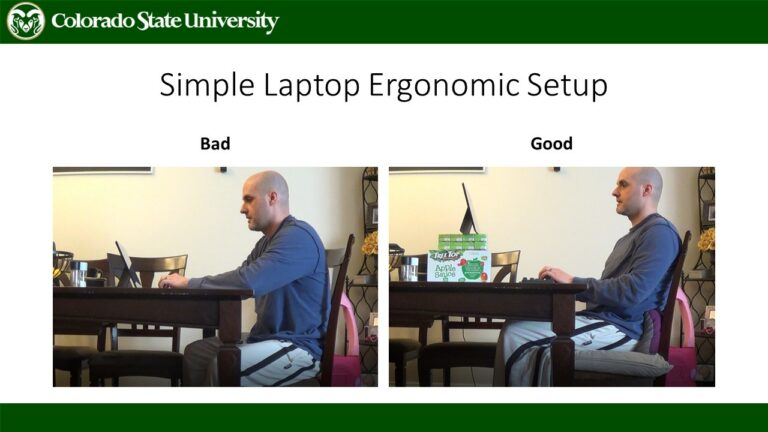Virtual/Remote Office Ergonomic Evaluation
As the number of employees working remotely have increased, so has the risk for pain and discomfort due to poor workstation setup. Many of us do not have the same workstation setup and equipment for the remote or teleworking station as we do for the traditional off. Often times, the remote setup is inadequate in comparison. A computer workstation at home may surround a laptop computer on a couch, bed, or kitchen table. As comfortable as these options may sound, using an improper workstation set up for an extended duration can cause awkward posture which can increase the risk for ergonomic-related injuries (or musculoskeletal disorders such as tendonitis and carpal tunnel syndrome). It is important to set up your teleworking station as best you can to prevent injury regardless of where you might work.
As you attempt to set up your remote workstation, keep in mind that the Risk Management & Insurance Ergonomics Team is here to help and can provide remote/virtual evaluations. Our ergonomics specialists will work to identify and eliminate the causes of discomfort and help you set up your workstation, without ever having to set foot in your home.
Virtual Ergonomic Evaluation Steps and Scheduling
Learn more and request an Appointment.
Quick Work from Home Ergonomic Tips
If you are working from home for extended periods, it is recommended that you invest in quality ergonomics equipment including but not limited to a height-adjustable table or keyboard tray, and ergonomic chair. For the short term, you can make simple changes to your workstation using things you already have in your home. Some tips are as follows:
- Use a good chair (if possible). If you don’t have a good chair, add pillows for back/leg support.
- Raise your chair (most kitchen tables and desks are too high). Use a pillow as a seat cushion if needed.
- Support your feet on a phone book, step stool, etc., if they do not firmly touch the ground while sitting.
- Raise your monitor using books, old shoe boxes, etc.
- Use an external keyboard and mouse. It is essential that the monitor is separated from the keyboard/mouse. The top of the monitor should be at or slightly below eye level, shoulders relaxed with the elbows around 90 degrees.

Keep in mind that there is more to ergonomics than just the computer workstation. Environment, lighting, noise, safety and other related hazards (amongst others) should be accounted for as well. See the below resources for additional information. Contact the ergonomics manager with questions and look out for training and other information on our website, CSU listserves and CSU SOURCE.
More Ergonomic and Training Resources
Online Training
The Working From Home Ergonomics training is focused on the setup of the home office workstation set up, including no cost, short term or temporary solutions, movement and breaks, workstation environment and virtual evaluations. This is an online/on demand training that can be completed at the user’s convenience.
Laptop, Tablet, Smartphone Ergonomics
Laptops were designed to be convenient and used for short durations but unfortunately using a laptop has become a primary computer for many people. For more information on how to set up a laptop, refer to these guidelines.
.
Ergonomics for the Home Office
Ergonomics is about improving your comfort, heath, and productivity with thoughtful workplace design.
With more employees working from home, the temptation to sit in bed with a laptop and a cup of coffee leaves people susceptible to many risks. Humantech covers a few ways to improve office ergonomics at home in this blogpost.
Contact CSU Ergonomics
(970) 491-2724
